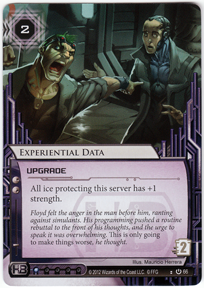Welcome to Card Game DB
Register now to gain access to all of our features. Once registered and logged in, you will be able to create topics, post replies to existing threads, give reputation to your fellow members, get your own private messenger, post status updates, manage your profile and so much more. If you already have an account, login here - otherwise create an account for free today!
Register now to gain access to all of our features. Once registered and logged in, you will be able to create topics, post replies to existing threads, give reputation to your fellow members, get your own private messenger, post status updates, manage your profile and so much more. If you already have an account, login here - otherwise create an account for free today!
Tech Talk - Experiential Data
Nov 27 2012 06:00 AM |
Scud
in Android: Netrunner
Android: Netrunner Tech Talk Scud Tech Talk is back after a short holiday break to discuss the strengths, weaknesses, and overall oomph of a specific card. This week we take a look at Haas-Bioroid's Experiential Data (Core).
Tech Talk is back after a short holiday break to discuss the strengths, weaknesses, and overall oomph of a specific card. This week we take a look at Haas-Bioroid's Experiential Data (Core).DOCUMENTATION: Haas-Bioroid likes to build big old servers defended by layers and layers of ICE. Why? Their in-faction bioroid ICE are strong for the cost and pack some of the most dangerous subroutines in the game, trashing programs, doling out the Brain Damage, and, of course, ending the run. However, any Runner can slow down and spend some time talking her way past one of those beefy bioroids if she has the clicks to spend. Hence the desire to stack several pieces of ICE at each server - you can talk your way past that Ichi 1.0 (Core) but then you won't have the time to schmooze the Heimdall 1.0 (Core) just around the digital bend. Makes sense.
And now we get to something Tech Talk has wanted to talk about for a while, namely the real value of ICE. Nasty subroutines on ICE are great. They can really put a dent in the runner's rig and her confidence. But subroutines tend to only fire off the first time you rez the ICE. Once the ICE is revealed, it really is nothing more than an economic speedbump, a math equation for the runner to solve. Of course money is time in Android: Netrunner and the game itself is all about tempo, so forcing the runner to find money to break subroutines is effective at slowing her down long enough for the Corp to do what it needs to do. This means that once a piece of ICE is rezzed, its real value is its Strength and the number of subroutines it has (which is why Archer (Core) is such a great card - 6 Strength and 4 subroutines means that even if it doesn't smash the runner's face, it's going to cost a lot of scratch to get through) - those two numbers are going to dictate the hit to the runner's tempo.
Altering the Runner's math is one of the Corp's most useful weapons. Currently, there are three choices to help the Corp: replacing rezzed ICE with new, unrezzed ICE; Corporate Troubleshooter; and Experiential Data. We'll get to the cards in a moment, but first, let's talk a little about that first, basic method of altering the Runner's math. The average Corp deck packs 18-21 pieces of ICE. When is the last time you played every piece of ICE in your deck? Yes, yes, part of the reason that a deck has so much ICE is to make sure you draw enough when you need it but, since you are going to draw more than you strictly need, why not put it to some use? As mentioned above, most subroutines only fire off during the run you first rez the ICE so isn't getting more unrezzed ICE out on the table a good idea? Of course you want to keep an eye on your economy - one of the most common mistakes of beginning Corp players is the tendency to spend credits putting out more ICE than they can afford to rez - but sometimes a mid-game surprise, one that not only alters the Runner's math in an unknown way but also might result in some painful subroutine going off, is just what the doctor ordered.
So, on to Experiential Data. It's hard to talk about that card without mentioning Corporate Troubleshooter (Core), since they are so similar. The key difference is, obviously, the fact that you only get one use out of Corporate Troubleshooter, which is why he allows you to pump an ICE's strength as high as you can afford. The subtle difference is what is interesting, though, and what may just make you appreciate Experiential Data more than you do. Corporate Troubleshooter does, indeed, mess with the Runner's math, but it is built to work with subroutines, so to speak. If you can't jack an ICE's strength high enough to ensure that the Runner gets hit with all the nastiness that ICE can put out, you are much better off keeping Corporate Troubleshooter unrezzed. The goal is to make it impossible for the Runner to pay her way through the ICE, which is great for wrecking her rig or draining her hand or whatever pain the subroutines dish out, but isn't all that great for draining her economy, since she;s not going to spend all her credits for the privilege of not breaking the ICE.
Experiential Data, on the other hand, is a long-term investment. On a server with three pieces of ICE, you are costing the Runner 3 additional credits to make a successful run (depending, of course, on her rig). That's three additional clicks worth of tempo on each run, which is nothing to sneeze at. The runner is going to need to spend time (cards/clicks) getting those credits, which is time she isn't running your servers. Even if the runner gets through and still has the credits to trash Experiential Data, you probably cost her 1 extra credit per ICE plus 2 credits to trash your Upgrade. That can delay the next run by as much as a full turn, which is pretty sweet.
In addition, Experiential Data has the very basic strength of being an Upgrade. Any card you can play face down into a server is a welcome addition to your Corp deck. You might not be able to advance it, but if you bluff properly, you may be able to get the Runner to blow a lot of late-game credits running on it in hopes of grabbing that last Agenda.
INSTALLATION: Experiential Data is going to get trashed as soon as the Runner is able to do so, which means you want to install it only when you have both a reason and the means to rez it on the next run. (Of course, this advice goes out the window in the late game when the bluffing situation mentioned above might win you the game; in that case, just drop it into your beefiest server with you last click and don't rez it until the Runner has decided to encounter the last piece of ICE.)
Remember that Experiential Data stacks with itself, so holding a couple in hand until the right moment, then installing them along with an Agenda (when you have a surfeit of credits, of course) can ensure a costly run that might buy you enough time to score.
Strangely, Experiential Data probably combines least usefully with Haas-Bioroid's bioroid ICE because the Runner doesn't need to pay anything to use clicks to break their subroutines. However, if you build one server three of four deep, you'll find that it can help make up for the credits the Runner saved spending clicks by jacking up the remaining ICE.
IMPLEMENTATION: Experiential Data combines well with Weyland Consortium's ICE, especially the titanic Archer. Runners tend to scrape by Archer because it can cost so much to break, often going so far as to let the "Gain 2 credits" subroutine fire off just to save a credit. Flipping an Experiential Data after the Runner has chosen to encounter an Archer might let you get off one of the other subroutines. The Runner will probably choose to leave the "End the run" subroutine unbroken in order to save a program, so why not make sure that Archer is the last ICE, the one closest to the server, so that they've spent a bunch of money only to be foiled at the last moment?
NBN's in-faction ICE pairs well with Experiential Data, as well. Tollbooth (Core) will cost them an EXTRA credit, Data Raven (Core) will require them to hold onto an extra credit if they want to ditch the unavoidable tag. Matrix Analyzer (Core)? Well, two out of three ain't bad, right?
Jinteki can benefit from the little extra boost that Experiential Data gives since a lot of its ICE damages the Runner and that means that Runner's are less likely to want to leave a subroutine unbroken in order to save some cash. In addition, another face-down card can only add to the mind-games that Jinteki likes to play.
COUNTERMEASURES: Try to run with a few more credits than you need to make it through a stack of already rezzed ICE. Experiential Data feels a bit like PAD Campaign when you find it installed in a server - is it really worth the 2 credits to trash it right now? Unlike the PAD Campaign, the answer is always yes when it comes to Experiential Data. The card will cost you more credits than that after, at most, three runs (and that's if it's installed on a server with only 1 piece of ICE).
- Pentadude, Dahras and HaphazardNinja like this



 Sign In
Sign In Create Account
Create Account












3 Comments
Thank you!
I have noticed that Corp players are really gunshy about replacing pieces of rezzed ICE and I think that, while it's not always the correct move, it isn't always incorrect, either (for all the reasons given above). Sometimes hitting a Runner with just one good subroutines (Trash a program, for example) is all you need to swing the tempo back your way for the late game.